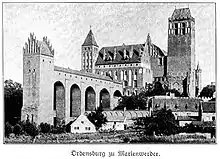Dansker
A dansker (also danzker) is a toilet facility, belonging to a castle, that is housed in a tower over a river or stream. The tower, a type of garderobe tower, is linked to the castle over a bridge, which has a covered or enclosed walkway. The dansker is frequently found on German Ordensburgen and is an architectural feature of the 13th and 14th centuries.

.jpg.webp)
The origin of the word, first used in 1393, probably comes from the town of Danzig.
A famous example is the dansker at Kwidzyn Castle in Poland, although it was rebuilt in the 19th century and no longer retains its medieval appearance.
If danskers or a garderobe were not available, outhouses served as toilet facilities in castles. However, if many people stayed in the castle permanently, these were no longer sufficient, and a separate exit over running water was then more appropriate. That is why Dansker are mainly found at German Ordensburgen, which were constantly occupied by a large number of knights.
References
- Horst Wolfgang Böhme, Reinhard Friedrich, Barbara Schock-Werner (ed.): Wörterbuch der Burgen, Schlösser und Festungen. Reclam, Stuttgart, 2004, ISBN 3-15-010547-1, p. 108.
- Dansker. In: Ernst Seidl (ed.): Lexikon der Bautypen. Reclam, Stuttgart. 2006, ISBN 978-3-15-010572-6, p. 115–116.
- Walther Huber: Dansker. In: Reallexikon zur Deutschen Kunstgeschichte. Band III. 1954, Sp. 1050–1052 (online).
- Otto Piper: Burgenkunde. Ackermann, München 1895, S. 505–510 (Digitalisat in der Google-Buchsuche).
External links
- Dansker (gdanisko) at medievalheritage.eu (pl)